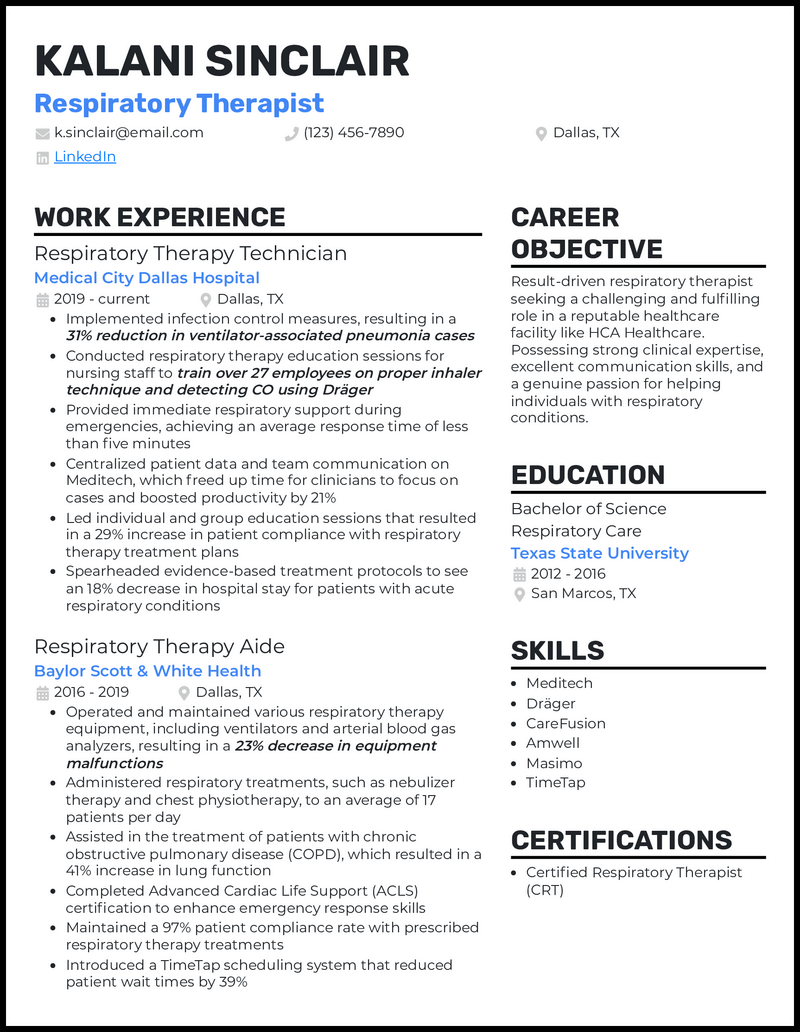As a respiratory therapist, you deliver optimal care, managing ventilators one minute and administering the proper doses of assistive medications the next. You’re also at the ready should emergency intervention become necessary.
But how do you deliver all the details about what you can do in a compact one-page resume? What do recruiters really want to see before hiring their candidate of choice?
We’ve got this. After years of helping professionals like you in the medical field, we’ve assembled three respiratory therapist resume examples and added some helpful cover letter writing tips to get you started.
Related resume examples
What Matters Most: Your Skills & Experience History

Anything medical is bound to be super technical, so make sure your skills list is, too! Provide recruiters with any job-specific software programs or specialized respiratory and assistive equipment you use.
Ensure your skills closely align with the job by honing each one. A general rule: If your skills easily apply to plenty of other fields, they don’t say much about your individual candidacy for this specific role as a respiratory therapist!
Provide very specific job skills. Name those programs that help you monitor patients’ health, and word any soft skills you include here in a way that ties them to your profession:
9 most popular respiratory therapist skills
- Meditech
- Amwell
- Drager
- CareFusion
- TimeTap
- Masimo
- Respiratory Education
- Patient Records
- Treatment Calendars
Sample respiratory therapist work experience bullet points
Tailor each component of your resume to the job description and its organization, just like you adjust treatment for each patient’s unique respiratory difficulties.
Your work experience is meant to demonstrate that you have an impressive set of skills and know how to use them. How did your familiarity with TimeTap help avoid appointment conflicts for a more fluid patient experience and greater efficiency for your team?
Each experience point should be honed and polished like your skills, adding plenty of job-specific value to your respiratory therapist resume. Metrics are valuable tidbits of information you can impress recruiters with. You need to be able to quantify your success and its impact.
Think of percentages that show how your attentiveness impacted patient recovery rates. Provide quantifiable data like personal feedback ratings or reduced work hours, thanks to your efficiency!
Draw inspiration from these samples:
- Assisted in the treatment of patients with chronic obstructive pulmonary disease (COPD), which resulted in a 41% increase in patient lung function
- Provided immediate respiratory support during emergencies, achieving an average response time of less than 5 minutes
- Operated and maintained various respiratory therapy equipment, including ventilators and arterial blood gas analyzers, resulting in a 23% decrease in malfunctions
- Compassionately administered respiratory treatments such as nebulizer therapy and chest physiotherapy to an average of 17 patients daily, earning a personal patient feedback rating of 4.8/5 stars
Top 5 Tips for Your Respiratory Therapist Resume
- Compare: Summary vs. objective statement
- If you’re switching careers, fresh out of medical school, or enthusiastically applying at a more entry level, you could benefit from a resume objective. State why you want the job and what qualifications align you with the organization. If you’re professionally experienced in your role, highlight your excellent candidacy or let your experience points speak for themselves!
- Leverage context
- Context (the “why?” of your experience point) can provide intrigue, making your resume into a success story that keeps the reader hooked. What motivated you to overhaul the patient data management system and reduce errors? Why did you feel compelled to work harder than ever to reduce patient wait times?
- Name key tools in experience points, too
- Your areas of proficiency aren’t just for your skills section! While you’ll want to keep the most impressive skills for your list, you can work in other abilities you use to help your patients. Working competencies from your skills list into your experience points with context and metrics also sets off your depth of knowledge!
- Keep it to one page
- Make sure you stick to a one-page resume. Recruiters have, on average, a few seconds to give your resume that crucial first read-through. So, make some compelling points in favor of your excellence in respiratory therapy fast!
- Other experience sources count, too:
- If you haven’t worked as a respiratory therapist, you can turn to other sources of relevant work experience like internships, volunteer initiatives, or participation during college in academic programs related to your field.
Don’t! If you have compelling experience points that are hard to part with, or if that story about how you helped patients attain miraculous recovery rates could use more detail . . . Put them in a cover letter!
If you have any professors, previous employers, or coworkers who can vouch for job skills you have that will translate to your new role as a respiratory therapist, ask them for professional letters of recommendation.
If you have specialized certifications related to the role, don’t leave them out. If you have extra creds like CPR or Basic Life Support (BLS) recognition, include them in your resume. They’ll probably look best alongside your education, but you might want to give them their own section if you have several.






